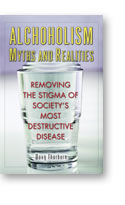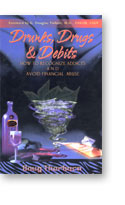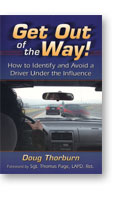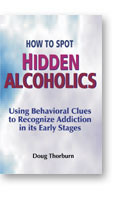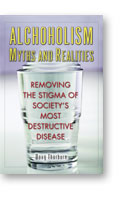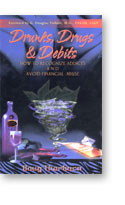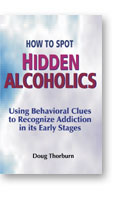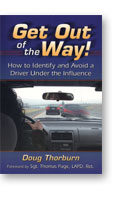 |
|
Issue #70 - June/July 2012
|
|
We hope you are enjoying the “What Would You Do?” stories now sent most weeks between issues of the regular Thorburn Addiction Report. We are always interested in your comments and leads to new stories. Also, be sure to check out our client letter, Wealth Creation Strategies; the top story in the latest issue is Edgar Allen Poe-like in its manifestations—and keep in mind, Poe was the greatest alcoholic writer of horror stories. Only this is all-too-real.
The Top Story in this issue would ordinarily qualify for “Sometimes, it takes an addict,” but there is so much more to the story. The “runner-up” once again shows that white collar crime, including tax fraud, seems to require addiction (this one’s a classic!). The “Public policy recommendation” is something I’ve long pondered and truly invite your comments, as I’m only scratching the surface of the legal issues this could create. As always, the “Antic-of-the-month” is a story of an addict who got lucky and lived, even if she deserved the Darwin Award. Please read on and enjoy!
|
|

|
Welcome to the Thorburn Addiction Report in which we interpret the news through the lens of alcohol and other drug addiction. Each month, we bring you several sections, including: 1. Top Story of the month along with runners up, persons under watch, enablers, disenablers and more 2. Review or Public Policy Recommendation of the month 3. Dear Doug in which a recent letter to "Dear Annie" or other "help" column is rewritten, with responses given from the unique perspective that alcohol or other drug addiction best explains the misbehaviors described 4. Alcoholic Myth-of-the-Month 5. Alcoholic Antic-of-the-Month, usually where someone deserves the Darwin Award, but lived. There is something for everyone!
Addiction Report Archives here
© 2012 by Doug Thorburn
|
|
The blog is open to your comments. We’ll be interested in any thoughts you, our loyal readers, may have.
Books Here
|

Sometimes it Takes an Addict: The Duality of Rodney King’s Life
Drunks, Drugs & Debits describes numerous cases involving the wide-ranging negative impact of addicts’ behaviors. One such case was a classic:
“…[and] we are all indirectly affected by addicts’ behaviors. The damage one addict inflicts can, in fact, be monumental and injure practically all of us. Regardless of the police officers’ behavior, [an alcoholic] was high on alcohol and other drugs when he led them on a 100-mph car chase. When he stopped, he violently resisted arrest. Entire sections of Los Angeles [later] burned to the ground, a billion dollars in property damage resulting [from] one man’s [addictive use]….The results of such addicts’ behaviors are reflected in our insurance rates and higher taxes for police, prisons and public health….”
The alcoholic referred to is well known, but the name doesn’t really matter; it could have been any alcohol or other-drug addict. Those with the disease of alcoholism suffer from distorted perceptions that sometimes cause the afflicted to think they are invincible and above the law; they take risks, do things and act in ways the sober person would never consider. As a result, they often change the world, for better or worse and sometimes both.
Rodney King, dead at 47 from the (likely) intersection of too much booze and a swimming pool, was indirectly responsible for 53 deaths, 2,373 injuries and nearly $1 billion in property damage resulting from the 1992 Los Angeles riots. Oddly, for all of his faults and without giving undo credit (although a few days after the riots began he made an impassioned plea, “Can we all get along?”), he may have done some good. An independent commission created in the wake of his beating issued a scathing report on the culture of the LAPD, helping to remake the force over the following decades into one that racial minorities can trust (at least more than before). While King changed many lives for the worse—those who were killed, their family and friends, those who were injured or had their homes or businesses destroyed or property stolen—his misbehaviors likely drove positive change for future generations of Los Angelinos. Nevertheless, as I often remark about even the most productive addicts, The world would be a better place without their positive contributions if, in exchange, we could avoid the extraordinary harm they inflict.
In early 1991, King drove from police at speeds of up to 115 mph because he was on probation from a previous robbery conviction and was under the influence. He knew he’d go back to jail if stopped—so, with drug-addled brain and confabulated thinking, he tried to escape. When the car was finally cornered, his two passengers were taken without incident; King, on the other hand, fought with the officers for some time before the infamous videotape and beating began (see this page for the amazing description). This resulted in an “apparent” over-reaction by police—“apparent” because police are all, by the nature of their jobs, codependents (which, because they are dealing with insanity, can make any rational person do crazy things). In a radio interview shortly before he died King claimed he’d had only a few drinks before being pulled over that night. However, five hours later his blood alcohol level was nearly .08 per cent. He obviously didn’t have just “a few drinks,” unless you count as a “few” three 28-ounce Long Island iced teas; his BAL had to have been at least .16 per cent at the time of the incident, which requires 11 drinks, the equivalent of more than 16 ounces of 80-proof liquor over the course of four hours for a 200-pound person. The radio interview demonstrates he was still doing what addicts do: lying.
In another interview, he said he didn’t buy the notion that addicts can’t drink and be sober. “All addicts are different,” he said. “And I’m different. I’ve learned that I’m one of those who can manage it.” As he dabbed peanut butter between his teeth at 9:30 a.m., he explained to a journalist that it was an old drinker’s trick to mask the smell of alcohol. His drinking was just “a sip here, a sip there. It was never out of control.” The journalist never saw the pre-drinking, which we know occurred because no addict can “sip” unless the blood alcohol level is where he wants it, something well north of .12 per cent.
King got sober for periods of time, including during his stints on “Celebrity Rehab” and “Sober House.” He was a nice guy when sober. Hell, he was often a nice guy when he was drunk. The problem was those darned addiction-induced unpredictable misbehaviors. In his case, those misbehaviors wreaked havoc, even though the worst of it was indirect and committed by other addicts. At least, among the ironies that encompass addiction, he may have inadvertently done some good.
|
|
Runner-up for top story of the month:
Krystle Marie Reyes, 25, accused of tax evasion, theft and computer crimes in which she duped the state of Oregon into giving her a $2.1 million tax refund on reported earnings of $3 million. Having $2.1 million withheld suggests, in a state with a virtual 9% flat tax on all taxable earnings, at least $23 million of income. Returns on which such earnings are reported would rarely, if ever, be self-prepared (she used Turbo Tax). However, despite the return being red-flagged by Oregon’s automated system, in a subsequent manual review state workers (incredibly) OK’d the refund, which was loaded on to a debit card for Reyes. This occurred despite at least three glaring red flags: an impossibly high withholding-to-earnings ratio, self-preparation of a very high-income return and loading this much money onto a debit card. Her scam might not have been discovered was it not for Reyes reporting the card lost or stolen after she debited $150,000 on various extravagances. Before I saw the drug for which she was also arrested, simply seeing her face here and reading the basics of the crime, I blurted out to my office-mate Kristin, “It’s got to be meth.” Indeed. But I’d like to know what the state worker(s) who approved the refund was/were using. If it’s an inside job (the Oregon Department of Revenue is looking at the possibility), I’ll predict either alcohol or meth is on board in a very big (i.e., addictive) way. By the way, I didn’t notice the caption under the picture in which meth was mentioned before identifying her as a likely meth-head. Unsurprisingly, several other sources on a Google search failed to even mention the meth possession charges—without knowledge of which we can’t begin to fathom her sense of invincibility. Isn’t it amazing how understanding addiction makes sense of so much that would otherwise be nonsensical?
Under watch:
In an early 2009 piece on white collar crime, The Economist magazine mentioned something those who have read my books would predict: “Many [Club Fed and other white collar] prisoners suddenly discover, post-conviction, that they had a drinking problem….” I would add that those who don’t figure this out might benefit from greater introspection. In the spirit of The Economist’s discovery, a few recent stories follow for which the evidence of alcoholism is in the purported behaviors or alleged crimes themselves.
Former U.S. Senator John Edwards (D-NC), 59, found not guilty of one charge, with a mistrial declared by the judge on five other charges of violating multiple campaign contribution laws in a failed attempt to cover up an extramarital affair with Rielle Hunter, 48, a wannabe actress. Hunter hit her biggest show business payday when Edwards arranged to have her paid $250,000 to make a series of behind-the-scenes documentaries of his 2008 campaign while running for President. Inasmuch as he is—as are most politicians—well-protected by enabling journalists, there are only occasional references in news reports to Edwards’ possible alcoholism, such as “is he really partying?” and “under tremendous stress, Edwards had also been drinking too much.” However, journalists have no such qualms about an otherwise unknown like Hunter, whose life one writer describes as having had “a lurid, supermarket-tabloid quality to it—full of deception, betrayal [and] reckless behavior” before she turned 30 and found she needed “spiritual growth.” An ex-boyfriend, writer Jay McInerney, based his “cocaine-addled, sexually voracious” narrator of his 1988 novel “Story of My Life” on her earlier exploits.
Rep. Jesse Jackson Jr., 47, whose office, after he was inexplicably missing from the House floor for more than a month, finally issued a statement saying Jackson is “receiving intensive medical treatment” for a “mood disorder.” Such disorders are usually caused or mimicked by alcoholism. The statement was given two weeks after his office released another statement saying he was on medical leave and suffering from “exhaustion,” which is almost always a euphemism for “alcoholism.” Oddly, based on the description of his personal life at Wikipedia I would ascribe much lower odds of alcoholism in him than in his famous father, the Rev. Jesse Jackson, but it wouldn’t be the first time public expectations don’t match private reality. We’ll have to wait and see.
Russell Wasendorf Sr., 64, founder of Peregrine Financial Group, Inc., hospitalized in critical condition after a suicide attempt, following a number of seemingly inexplicable events surrounding him and his firm. His company had just come under investigation by the National Futures Association for alleged falsification of bank records amidst accusations it held only about $5 million in funds of the $225 million it claimed to have in a deposit account. Wasendorf gave his son power of attorney to act on his behalf a few days earlier, which was two weeks after he got married—to a woman family and friends believed he was due to marry several weeks in the future. Huh? Whenever we shake our heads wondering, “What the hell is going on here?” and read descriptive phrases in stories such as “erratic moves,” “the mystery deepened” and “adding to the puzzles,” we’ve got to look for alcohol and other-drug addiction. The alleged fraud and suicide attempt all but confirm high (80-90%) odds of substance addiction explaining all of the behaviors.
Still, it’s helpful to have stories of private behaviors. An anonymous but extremely credible source told me Wasendorf walked into a room at a hotel conference, screaming and cursing out a hotel employee because directional signs hadn’t initially lead him in to the right conference room. Most people would think “he’s just having a bad day; cut him some slack.” Sorry, but berating of an innocent is a terrific clue to alcoholism. If an addictionologist observed such a reaction on the part of a head of a firm with whom he had funds, he would immediately move all of his funds to another brokerage firm. Since investors may not get all of their missing funds returned to them, we can see that understanding alcoholism is immensely helpful at times—if you see the behavioral indicators and take them seriously.
Headline of the month:
“Sage Stallone ‘Didn’t Drink’ Says Attorney”
So said Stallone’s lawyer and close friend George Braunstein in commenting on Sage Stallone’s tragic death at age 36. “There was a report that his room was filled with liquor bottles. Actually, they were empty bottles of Dr Brown’s Cream Soda….I don’t think it has anything to do with drugs, he wasn’t that kind of guy.” Braunstein insisted (his words), “He wasn’t anyone trying to take his life.” Mr. Braunstein, I hardly know where to begin, but let’s try to dispel the myths you are helping to promulgate. 1. The annals of alcoholism are filled with those who managed to hide their use from friends, co-workers, parents and even spouses for years. We must always bear in mind Nassim Taleb’s admonition, especially when dealing with alcoholism, “we don’t know what we don’t know.” Jodie Sweetin’s LAPD cop husband, to whom she was married for five years, didn’t know: she was a full-on methamphetamine addict for at least two of those years. Sage’s famous father Sylvester Stallone may even have been flummoxed. 2. Your comment, “he wasn’t that kind of guy,” implies only “bad” people use drugs. Mr. Braunstein, addiction is inherited. It has nothing to do with morality or lack thereof. Addicts are born with an ability to use drugs addictively. If you are not an addict, try using like one; you will find you can’t. In recovery, most addicts prove to be wonderful, endearing and highly intelligent individuals. If Stallone died of a drug overdose, it’s tragic. It doesn’t mean he was a bad person; get past the stigma, so you can view with an open mind whatever evidence appears. 3. Most overdoses are not attempts at suicide; they are inadvertent. If Mr. Stallone’s death proves to have been a drug overdose, Mr. Braunstein, the behaviors were probably right in front of you for years.
Robert Rhine, editor-in-chief of Girls and Corpses magazine, might agree. He is troubled by the fact that he saw “the signs,” while people around him claim “there were no signs.” He told TMZ he did a photo shoot of a friend of Sage’s for the magazine at Sage’s home in May. According to www.hollywoodlife.com, Rhine “waited 45 minutes for Sage to answer the door,” who then stumbled around appearing as if he was “on something” while slurring his words, acting “very similar to Ozzy Osbourne.” Anything close to Ozzy suggests longstanding addiction. Both Rhine and police officers reported that Sage’s house was “disgusting,” which is consistent with late-stage poly-drug addiction. Mr. Braunstein, just because you never saw Sage drink or use doesn’t mean he didn’t. And get over the idea he “couldn’t have been one.” Some of the nicest, most productive and most successful people in history have been drug addicts.
Sometimes, it takes an addict:
Henry Hill, who inspired Martin Scorsese’s film “Goodfellas,” dead at age 69 following decades of heavy smoking and years of heart disease. After an arrest in 1980 on charges of drug-trafficking and facing a long prison term or possible execution by his former crime bosses, Hill became a government witness and helped send dozens of former associates to prison. He was expelled from the government’s witness protection program in 1987 after “relentless misbehavior” including drug possession; amazingly, he managed to survive another 25 years outside the program, with many of those he feared either dead or in prison. While claiming to have never murdered anyone, he knew, by his own admission, where a “great many bodies” were buried—literally. He originally wanted to be a priest, but no doubt triggered his lifelong addiction to alcohol and other drugs early on, so that idea “didn’t work out.” Instead, he was seduced by “the flash and dazzle of the neighborhood wiseguys, with their sleek cars, glinting rings and glittering women.” Aside from dealing drugs, he committed arson, numbers running, truck hijackings and loan sharking. Most infamously, he was involved in the 1978 Lufthansa heist at Kennedy International Airport in which $5 million in cash and $1 million in jewels were stolen (up to that time the most lucrative cash robbery ever in the United States), as well as a point-shaving scandal in which basketball players at Boston College were bribed to fix games. Later in life, although easily bored, he found time for ordinary pleasures including, as he often said, never missing an episode of “The Sopranos.”
Note to family, friends and fans of the above: the benefit of the doubt is given by assuming alcoholism (they are either idiots and fundamentally rotten, or they are alcoholic/other drug addicts—which would explain the misbehaviors). If alcoholic, there is zero chance that behaviors, in the long run, will improve without sobriety. An essential prerequisite to sobriety is the cessation of enabling, allowing pain and crises to build. Thus far, many have done everything they can to protect the addict from the requisite pain, making these news events possible. The cure for alcoholism, consequential bad behaviors and, ultimately, tragedy, is simple: stop protecting the addict from the logical consequences of misbehaviors and, where possible, proactively intervene.
|
|

|
|

Should Enablers be Held Responsible?
Vernon Johnson, in I’ll Quit Tomorrow, explicated that every alcoholic experiences euphoric recall, causing him to view everything he says or does while under the influence through self-favoring lenses. James Graham, in The Secret History of Alcoholism, expounded that the early stages of the disease are characterized by an inordinately large sense of self-importance (inflated ego) something first written about by Harry M. Tiebout in his fabulous pamphlet Ego Factors in Surrender in Alcoholism. During my research while writing Drunks, Drugs & Debits, I realized that Johnson’s euphoric recall triggers Graham and Tiebout’s alcoholic egomania, which increases over the progression of the early- to middle-stages of the disease. Over time, egomania and its behavioral manifestations can “slop over” to periods between uses; this allows hidden alcoholism to be more easily identified. Regardless of whether we see the person while under the influence, as misbehaviors increase the odds of alcoholism also increase. Even without seeing any use, if serial misbehaviors are evident we can ascribe about 80% odds that the person under scrutiny experiences euphoric recall and is, therefore, afflicted with alcoholism. This insight is incredibly helpful in protecting ourselves from the erratic and often dangerous behaviors in which addicts engage.
Alcohol and other-drug addicts commit at least 80% of unethical and criminal behaviors, including felonious ones. Addicts don’t have to be under the influence while committing misbehaviors; many feign sobriety when they are only temporarily abstinent. Sobriety requires both abstinence and ego deflation, an admission they are not all-powerful. Since the commission of a crime generally requires an inflated sense of self, the addict who commits such crimes is by definition not clean and sober. Since a cause and effect relationship exists between active addiction and the commission of criminal acts approximately 80% of the time, the number of criminal acts obviously would drop if we could get more addicts clean and sober. It follows that crime prevention should focus on cleaning up addicts rather than reacting to misbehaviors and focusing only on punishment.
Criminals commit an estimated 100 crimes per crime for which they are dealt appropriate consequences and possibly many times that in acts involving questionable ethics. Arguably, every tragedy that occurs in an addict’s life is preceded by dozens if not hundreds of incidents for which close people or the law should have intervened but didn’t. Two separate incidents involving law enforcers—a police chief’s wife and a former detective—are prime and tragic examples of likely known addiction. Unfortunately for everyone involved, their addiction seemingly was allowed to progress unimpeded.
Brinda Sue McCoy, 49, hazy from prescription pills and martinis, got into an argument with her husband, a former councilman and police chief in Orange County, California, and teenage son. Trying to avoid further confrontation, the husband and son left the house. She became suicidal, grabbed her husband’s loaded service weapon and barricaded herself inside the family home. She called several friends, a daughter and a nurse practitioner and told them which two songs she’d like played at her funeral. When police arrived, having already warned a 911 operator she’d shoot anyone who tried to interfere with her impending suicide, she shot twice and hit police cruisers the police were using as barriers; fortunately, no one was injured. She was convicted on five of six felony counts and could draw a 29-year prison term. Out on bail pending sentencing, she tried to kill herself and was remanded back to jail.
Anthony Nicholas Orban, a former Westminster, California police detective, shared eight margaritas and two pitchers of beer with a friend and sought a sexual encounter. He kidnapped and then raped a 25-year old waitress in a hotel room. He didn’t remember the rape and “came to” shortly after the criminal act, having no idea how he or the waitress got to the room. His attorney argued he was rendered “mentally unconscious” by a “powerful” dose of Zoloft and was, therefore, not responsible for his actions. (And by the way, Zoloft is not a psychotropic drug like Xanax, which is also used in treating depression.) Although neither the defense nor prosecution identified it as such, Orban was almost assuredly in an alcoholic blackout, during which time alcoholics can commit heinous acts they will never remember because the events don’t enter the memory banks of the brain. The jury convicted him and he now faces life in prison. Recall from issue #69 of TAR the story of U.S. soldier Robert Bales, by all accounts “a nice guy,” who murdered 17 Afghanis during an alcoholism-induced blackout. Bales could easily have done what Orban did, and vice versa. Perhaps Zoloft interacted with alcohol to create especially awful behaviors, but it doesn’t matter.
Brinda Sue McCoy’s husband likely knew what he was up against: an alcoholic wife. And Anthony Nicholas Orban’s cop friends, associates and captain almost certainly knew they had an alcoholic detective on their hands. Both addicts had probably engaged in dozens and possibly hundreds of incidents for which close people and especially the law should have intervened but didn’t.
Currently, the law proscribes that an absence of memory of an incident is by itself enough to absolve the perpetrator of responsibility for a crime. However, what if that person has been apprehended for crimes multiple times—and he had never been forced to face, address and deal with the root cause of the misbehaviors and lack of memory? What if there were numerous incidents of unethical behaviors for which close people should have intervened, but didn’t? If alcoholism is a disease that causes the afflicted person to act in ways he never would when clean and sober, shouldn’t there be some absolution if the cause of the behaviors has never been properly addressed by those in a position to know about the problem? Consideration should be given to lesser sanctions and greater compassion against those who have never been confronted with their all-too-obvious addiction. Since most alcoholics are never confronted or made the subject of an intervention, it’s unlikely either McCoy or Orban’s family, friends or co-workers had ever properly confronted either of them.
On the other side of the coin, greater incentives on the part of those in a position to intervene to get them to do so would be helpful. We should consider sanctions against those who bypass obvious opportunities to intervene—particularly law enforcers in the broadest sense. This especially includes judges, who should be required to tell defendants, “You probably sit in front of me because, through no fault of your own, you inherited a genetic predisposition to addiction: when you drink or use, you act badly some of the time. Therefore, society can no longer allow you to drink or use any drug capable of causing distortions of perception and memory. In installing an ankle bracelet on you today to encourage abstinence, we hope you will find your way to sobriety, which requires ego deflation, possible only when you become abstinent. So that you may learn about the cause of and solution to your behavioral problems, the court recommends that you attend AA meetings or some facsimile as often as you can. We wish you the best of luck and remind you that any failure will result in remand back to jail or prison.”
A police force captain who observes a modicum of misbehaviors could warn officers, detectives and other law enforcers under them that this is what a judge will advise if the drinking continues. When close people including family, friends and employers use these words and act on them with appropriate disenabling and, where feasible, regular and random testing and ankle bracelets, there will be far fewer Brinda Sue McCoy, Anthony Nicholas Orban and Robert Bales-like tragedies.
We should consider taking this idea further, even if it would be a legal morass. Those in a position of power with an opportunity to intervene, but don’t, should face some sort of sanction(s). We could start with egregious and obvious cases and see how it goes, especially when involving law enforcers on whom the public depends for sound judgment and moral rectitude.
|
|

Now that I’m sober, my friends are no longer friendly
Dear Doug:
I formed close friendships with a group of women who became my bridesmaids, confidants and associates in my career. We raised our children together and celebrated together—a lot.
Nearly eight years ago I stopped drinking. Though my friends cheered me on initially, they dropped me when, in early sobriety, I didn’t attend their champagne brunches and ladies’ happy hours, doing what I had to do to stay sober.
They are smart women. I thought they grasped the idea of addiction when they conspired in an intervention for another friend.
I miss my friends and have invited them over, but they have generally snubbed my invitations and have never reciprocated. Do you think there is any way to reconnect with them?
Signed,
Sober, but missing my friends from the old life
Dear Codependent,
Other columnists might tell you just as your drinking affected others, so does your sobriety. They would correctly remind you that you are not the person your friends knew long ago, and they might not be able to adjust. They would suggest you simply and bluntly tell them your feelings—that you would love to enjoy dinner and music with them and would like very much to reconnect.
Other columnists wouldn’t quite get to the crux of the problem. The hint is, “they might not be able to adjust.” Why not? Because you’re sober and they may not be sober.
The clues to this are embedded in your letter: you “celebrated together—a lot,” with frequent “champagne brunches and ladies’ happy hours,” which I’ve a hunch isn’t just for the inexpensive appetizers and camaraderie. Your girlfriends were heavy drinkers and, therefore, possibly alcoholic ones like you. As I’ve pointed out in my works largely focusing on spotting hidden addicts (Drunks, Drugs & Debits and How to Spot Hidden Alcoholics), birds of a feather doesn’t apply just to birds. Alcoholics often hang out together. They can’t adjust because your sobriety will force them to consider their own drinking, which flies in the face of what they want to do—to continue drinking addictively.
You mentioned they are “smart” women. As you well know, “smart” has nothing to do with addiction. Addiction is a biological process that is genetically inherited—just as your hair or eye color is. And, being involved in an intervention doesn’t preclude addiction. Interventionists tell us there’s almost always at least one alcoholic among the conspiring members in every intervention, and sometimes even one who is prompted to ponder the possibility they’ve got a problem too.
In your sobriety, you’ve developed new friends. Focus on those. Let your old friends know you are still available, especially if they ever need a helping hand. They may come to you for the help they likely need and you can offer it, along with your experience, to them.
(Source for story idea: Ask Amy, June 15, 2012.)
|
|

“Life has not been kind to Erin.”
So said a caption in the National Enquirer underneath a picture of former “Happy Days” and “Joanie Loves Chachi” star Erin Moran, now 51, who played Richie Cunningham’s cute little sister Joanie. Life would likely have been fine had she not “frequented the local bar,” as a source for the story reported. The Enquirer writers observe Moran is “haggard, near-broke and living in a rundown trailer park,” but they fail to connect the dots between apparent alcoholism and her “unkind” life. The caption should likely have read, “Alcohol, and therefore alcoholism, has not been kind to Erin.” If our diagnosis is correct, Joanie, life will be much kinder when you get sober. We’re rooting for you!
|
|

Story from “This is True” by Randy Cassingham, with his “tagline:”
“FREAKS OF NOMENCLATURE, BILATERAL DIVISION: Two weeks after graduating from the University of Colorado, a 21-year-old student allegedly went into someone else's Boulder house at 3:30 in the morning. When the shadowy figure entered the bedroom, the homeowner yelled at the intruder to get out -- and he had a gun. When the figure came closer, the homeowner fired a shot, and the intruder dropped. Zoey Ripple, 21, police say, had a blood-alcohol level of ‘above’ 0.2 percent; she was hospitalized with a gunshot wound to her hip. The homeowner will not be charged, police say, as Timothy Justice was acting in self defense. Ripple will be, though: felony criminal trespass. She likely won't see jail time. ‘We see this pretty frequently,’ said District Attorney Stan Garnett, and the goal of prosecutors is for the court ‘to help the person get the treatment they need for their drinking.’ (RC/Denver Post) ...After the trespass: just one shot. Before the trespass: way too many shots.”
The DA’s comment, “We see this pretty frequently,” seems shocking. I run across many stories in which drunks enter someone else’s home thinking it’s their own, but not even I’d have dreamt it was that common. Although in this case the alcoholic got lucky, there are countless ways for alcoholics to kill and be killed (alcoholism is the third most prevalent cause of death in adults under 59 throughout the world) and now we can add one more possible cause of death that even the most creative writers of fiction could never have thought of—if it weren’t all too real.
(Story and tagline from “This is True,” copyright 2012 by Randy Cassingham, used with permission. If you haven't already subscribed to his newsletter—the free one at least, or the paid one I get, with more than twice the stories—I highly recommend it: www.ThisIsTrue.com.)
|
Comments
To view reader's comments on last month's Thorburn Addiction Report and Doug's responses please visit the Thorburn Weblog at PrevenTragedy.com.
Thorburn Blog
|
Doug's new book, Alcoholism Myths and Realities, is now available at
GaltPublishing.com, Amazon.com and bookstores near you.
"Every policymaker in America needs to read your book exposing the myths of chemical addiction...Excellent book."
— Jim Ramstad, Member of U.S. Congress (MN)
"My father died of alcoholism. His father died of alcoholism. Three generations of alcoholism is enough. Now is the time to abandon superstition and pseudoscience, to debunk the myths surrounding alcoholism, and to apply science to solving this problem. Doug Thorburn's book is a model example of how this should be done. Read it and be prepared to change your thinking on this important topic. When enough of us understand what is really going on with alcoholism, society can make the shift from treatment to prevention and intervention."
— Michael Shermer, publisher, Skeptic Magazine and columnist, Scientific American
Buy your copy of Alcoholism Myths and Realities for only $14.95 or get the whole collection PLUS a two-hour audio cassette from Galt Publishing for just $49.95 plus tax and shipping. That's a $72.75 value for only $49.95.
To order online, click the following link (be sure to put "TAR SPECIAL" in the comments section of the order form.) Orders can also be placed by phone: 800-482-9424 OR fax: 818-363-3111.
If you wish to pay by check, send the appropriate payment with your shipping information and the words "TAR SPECIAL" in the "memo" section of your check to: PO Box 7777, Northridge, CA 91327.
Click here to purchase any of the above Thorburn books
|

Have you visited the Prevent Tragedy Foundation" The Prevent Tragedy Foundation is a tax-exempt 501c-3 organization, the goal of which is to educate the general public on the need for early detection of alcohol and other drug addiction. The Foundation is intended to answer a question that has been all-but-ignored by similar organizations: what does alcoholism look like before it becomes obvious"
Click here to visit the Prevent Tragedy Foundation |
|
Subscriptions
The Thorburn Addiction Report is a free newsletter published by Galt Publishing and PrevenTragedy.com. Subscibe by visiting our web site at www.PrevenTragedy.com.
|
The Thorburn Addiction Report is available to newspapers as a regular feature column.
Inquiries are invited.
Copyright Doug Thorburn All Rights Reserved.
ALL broadcast, publication, retransmission to e-mail lists, WWW or any other copying or storage, in any medium, online or not, is strictly prohibited without prior written permission from the author. Manual forwarding by e-mail to friends is allowed if 1) the newsletter is forwarded in its entirety and 2) no fee is charged. Please forward no more than three issues to any one person -- after that, they should get their own free subscription. We appreciate people who report violations of our copyright to us.
TO COMMENT to the author,
send your email to report@preventragedy.com or write to
Doug Thorburn, P.O. Box 7777, Northridge, CA 91327-7777
|
 |




